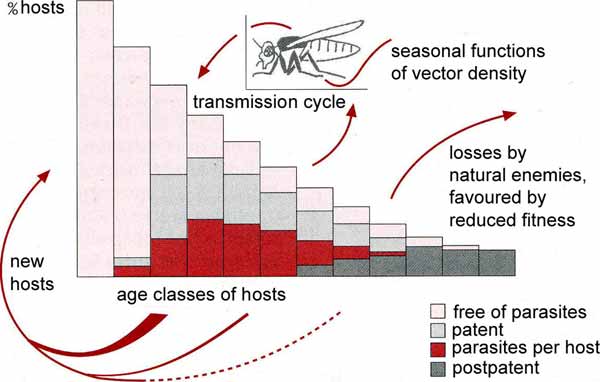 |
Abstract |
Abstracts |
|
1.1 What is parasitism? |
||||
|
The term "parasite", viz. one organism existing at the expense of another (the host), commonly also encompasses an individual leading some form of illegal life style. This unconscious discrimination prevents unbiased scientific questions. The hypothesis of attack and defence restricts research to therapy, prevention and control and limits animal parasitology to medicine, and plant parasitology to corresponding pest control. However, roughly a half of all known species, from viruses to vertebrates, are parasitic at least during one stage of their life-cycle. All organisms have parasites; indeed, even parasites possess superparasites. Parasites severely influence the ecological interactions of their hosts and thereby their evolution. Directly transmitted parasites, such as the roundworm Ascaris spec., can be controlled effectively by hygiene. Therefore, present scientific terminology in parasitology reflects discoveries in the field of bacteriology. However, hygiene measures are ineffective against cyclically transmitted parasites, i.e. those transmitted by vectors. The control of vectors combined with mass therapy remain inadequate and vaccines remain unsatisfactory. Within the subject of biology, parasitism is found in the sector of ecology, the environment of a parasite being a living organism. The parasite has to overcome the defence reactions of its host on the one hand, whereas on the other hand, the survival of the host must remain guaranteed. The parasite-host relationship has to achieve a balance of both requirements. Feedback mechanisms represent the only methods for preventing a definitive victory or defeat of one or the other partner. The most effective weapon of a parasite is its propagation. If the corresponding stages are not excreted (eggs in faeces) but remain in the host (microfilariae), they can be controlled by defence reactions of the host, i.e. by interspecific mechanisms. However, the least expensive, most effective mechanism is that of the selfcontrol of the parasite, i.e. by intraspecific mechanisms. These have to be adjusted to the physiological state of the host and have to be revealed by the parasite in response to specific signals of the host. Therefore, a theory of a balance of power characterized by the selfcontrol of the parasite’s propagation can be considered as an adequate hypothesis to explain the host-parasite relationship. Even the immune response of a vertebrate host can be used to signal essential information to the parasite for its selfcontrol. Plasmodium faciparum survives within a host not in spite of its immune response but with the help of this response (see fig. 2.2, page 15). The synchronisation of the parasite’s propagation with that of its host, as carried out by many nematodes and trematodes, compensates the age drift that every well-balanced parasite unavoidably experiences. At the population level, interspecific feedback mechanisms of directly transmitted parasites regulate the density of their hosts: parasitized hosts more often fall to prey to their natural enemies. The predator and prey relationships between carnivorous and herbivorous mammals are balanced by protozoan parasites, which are cyclically transmitted between the both (see chapter 2.8 Toxoplasmosis and sarcosporidiosis). Transmission depends on the contact rates between the relevant parasite stages and their hosts. Therefore, all density-dependent processes indicate the occurrence of feedback mechanisms. The definition of a parasite can briefly be given as follows (Crofton 1971a,b): A parasite is physiologically dependent upon its host. A parasite withdraws energy from its host, commonly as food. The reproduction potential of a parasite surpasses that of its host. A parasite affects the vitality of its host and might possibly kill it. The parasite load per individual host is overdispersed in the host population (fig. 1.2, page 7). The physiological (economical) dependency of two organisms was originally designated as a symbiosis sensu lato (De Bary 1879). It may be reciprocal and obligatory (1) or facultative (2), one-sided and non-pathogenic (3) or pathogenic (4) (Box 1.1, page 8).' (1) Symbiosis sensu stricto: both partners gain advantages, which are essential for their survival (3) Commensalism: the advantages of the smaller partner involve no disadvantages for the other.
|
 |
start |

